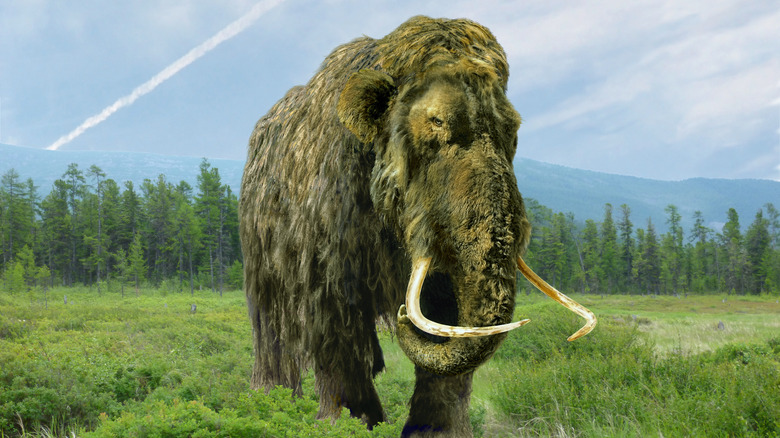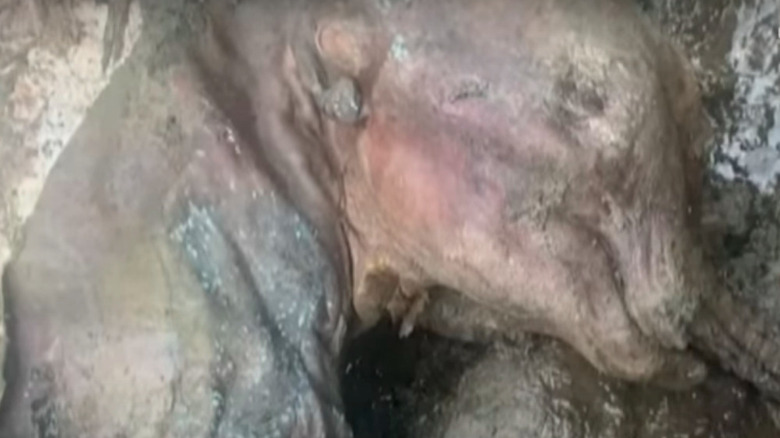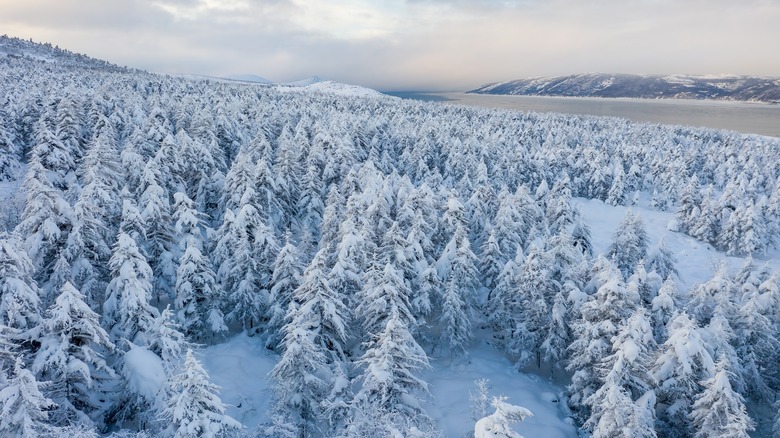Why A Rare Baby Woolly Mammoth Discovery Has Scientists Intrigued
Around 300,000 years ago, woolly mammoths could be found wandering through Europe, Asia, and North America (per National Geographic Kids). Live Science writes that this species strongly resembled modern-day Asian elephants. However, unlike elephants, woolly mammoths were completely covered in thick hair to insulate them from frigid Ice Age conditions. Additionally, they could grow to be up to 13 feet tall. Although it's unknown what exactly caused their extinction, Britannica theorizes that it was due to climate change. When that ice age ended 10,000 years ago, the weather simply became too warm for the woolly mammoths to survive.
Live Science states that humans have been able to learn more about woolly mammoths as various frozen remains have been discovered throughout the years. Most recently, in June 2022, CNET reported that a preserved 30,000-year-old baby woolly mammoth was found in the Klondike gold fields within Tr'ondëk Hwëch'in Traditional Territory in Yukon, Canada. A news release from the Yukon government explains that a miner was digging through Eureka Creek when he stumbled upon the mummified remains. The woolly mammoth, per the press release, has been named Nun cho ga, which translates into "big baby animal" in the Hän language.
It's the best-preserved woolly mammoth in North America
According to The Guardian, the baby woolly mammoth is believed to be a female that died when she was only 1 month old. Per Live Science, it's speculated that she got stuck in mud and suffocated after she strayed away from her mother. That being said, Discovery explains that Nun cho ga is so well preserved that both her hair and skin are still intact, as were her toenails and intestines (via NBC News). This means that she is considered to be the best mummified woolly mammoth ever found in North America. A news release from the Yukon government states that the last woolly mammoth found on the continent was in Alaska in 1948. Those remains, named Effie, however, were only partial.
Regarding Nun cho ga, Dr. Grant Zazula, a paleontologist from the Yukon government, told the Canadian Broadcasting Corporation, "She has a trunk. She has a tail. She has tiny little ears. She has the little prehensile end of the trunk where she could use it to grab grass." In fact, Discovery reports that grass was found in the infant's stomach. It's likely that she ate shortly before her death.
Dr. Zazula added that she was "beautiful" and that she had made his long-time dreams of seeing a woolly mammoth "face to face" come true (per the Canadian Broadcasting Corporation). After she was excavated, Nun cho ga was blessed by Tr'ondëk Hwëch'in elders.
The story of Lyuba, the woolly mammoth found in Siberia
NBC News reported that scientists hope that by studying Nun cho ga's remains, they will be able to gather more information about the lives of woolly mammoths. Moreover, they believe that this could provide them with more insight into other creatures, such as cave lions, from that ice age. Zazula explained to the Canadian Broadcasting Corporation "It's going to take days and weeks and months to sink in and it's going to take days and weeks and months working with Tr'ondëk Hwëch'in to decide what we do and learn from this." The Guardian states the last intact woolly mammoth was found in Siberia in 2007.
Per NBC News, those remains were named Lyuba. Similarly to Nun cho ga, Lyuba also died as an infant. According to My Modern Met, Lyuba was discovered by Yuri Khudi, a local reindeer herder. He left the site and returned with a team to retrieve her. Lyuba, however, was gone. Shortly after, she was found at a local store. Unfortunately, a dog had chewed off her ear and tail (via The Sydney Morning Herald). Besides this, however, she was fully preserved.
Earth Touch News Network reports that this allowed scientists to fully study her DNA. They were able to ascertain that she had drunk milk before dying and that she was only 35 days old. Like Nun cho ga, it seems that Lyuba also suffocated in mud. Since her discovery, she has been put on display around the world, including Australia and England.


